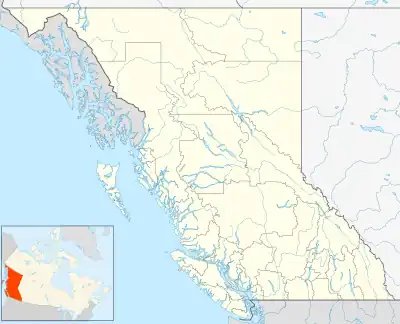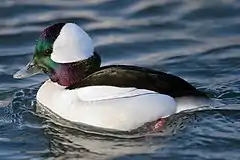Shoal Harbour Migratory Bird Sanctuary
Shoal Harbour Migratory Bird Sanctuary (SHMBS) is a protected area for migratory birds in northern Victoria, in British Columbia, Canada.
| Shoal Harbour Migratory Bird Sanctuary | |
|---|---|
 Location in British Columbia | |
| Location | Sidney, British Columbia, Canada |
| Coordinates | 48°40′20″N 123°24′39″W |
| Area | 150 ha (370 acres) |
| Designation | Migratory Bird Sanctuary |
| Established | 1931 |
| Governing body | Canadian Wildlife Service |
| Website | Shoal Harbour Migratory Bird Sanctuary |
Among 92 MBS in Canada, Shoal Harbour MBC is 146 hectares big and one of the early establishments made under the Migratory Birds Convention Act.[1] Migratory Birds Sanctuaries’ main goal is to protect migratory birds from numerous threats and to provide a safe, warm shelter during winter when their habitats are mostly frozen.[2] This is one of the implementations to accomplish the environmental missions that Environment and Climate Change Canada (ECCC) has called along with the Species at Risk Act to sustain biodiversity.[3]
About 35-40 species of birds inhabit the Shoal harbour area.[4] Three areas are composed of Shoal Harbour: Protected waters, Sidney Channel Bird Important Area, and Outer Coast. Each area has extinct characteristics, as particular species of birds are found in each sector.[4] With IUCN(International Union for Conservation of Nature) evaluation, the birds are distinguished into not evaluated, data deficient, least concerned, near threatened, vulnerable, endangered, critically endangered, extinct in the wild, and extinct.[5]
Geography
The sanctuary is about 30 kilometres from Victoria, the capital of British Columbia, with the nearest city being Sidney. It comprises several bays off of the Haro Strait in the Salish Sea, including Roberts Bay. It also consists of many small islands which become private stopover shelters for many migratory birds.[4] The Shoal Harbour MBS is mostly covered with shallow water and partially covered with tidal flats. Some have rocky surfaces with gravel and silt, some have sand and some have intertidal mudflats.[6] These mudflats are highly fruitful because of sea lettuce and eelgrass beds which feed many migratory birds. Also, during winter where every inland water is frozen, bays and mudflats become very significant habitats.[4] The sanctuary is divided into several areas, including Roberts Bay, All Bay / Resthaven Park, Marina Park / Marina Shoreline, Blue Heron Basin and Tsehum Harbour Park / Westport Marina Shoreline.[6] Some areas are filled with anchored boats and ports and are still going through increasing development of marinas which can cause disturbance to birds and other marine creatures.[7]
Roberts Bay
Roberts Bay is an enclosed bay separated from other bays in SHMBS and located in the southern area of the sanctuary. Due to less marina development and more resources for birds to survive compared to the other areas, it is easy to observe almost half of all migratory birds, mostly dabbling and diving ducks, visiting SHMBS at Roberts Bay.[6]
All Bay / Resthaven Park
Above Roberts Bay, All Bay has a very high density of marina and boats and there is a huge residential development near Resthaven Park as well. This area is quite popular with shorebirds due to the relatively large coverage of mudflats and abundant feed for them. However, compared to Roberts Bay, where there are fewer marina developments and pollution, a smaller number of migratory birds visit this area.[8]
Other areas
Marina Shoreline is relatively more widely open and contains mostly parks and partially a gravel beach, and similar to All Bay, residential and marina developments go on, causing high boat traffic. Additionally, Tsehum Harbour and Blue Heron Basin undergo these developments, leading to having the lowest bird density during migration periods. These areas are not as suitable for birds as Roberts Bay due to pollution and high disturbance. [8]
Ecology

Bufflehead (Bucephala Albeola)
Bufflehead migrates short distances, and breeds mainly occur in Alaska, British Columbia, Alberta, and Saskatchewan. Their habitat is forest, wetlands, marine neritic, marine coastal/supratidal. Their nesting begins usually in late April and late May and ends in early July and mid-July. However, due to the loss of trees due to agricultural expansion, Bufflehead is losing its nesting place. Also, breeding occurs in Manitoba, Ontario, and Quebec. The population began to increase in the 1960s. Since 1970, the population of this species had a large increase, which made the current population considered stable and acceptable. Bufflehead was considered a “Priority Species” in the Bird Conservation Region Strategy in 2013. In 2015, Wild Species (Canada) presented that Bufflehead is in secure status. Later in 2018, the IUCN (International Union Conservative of Nature) stated that Bufflehead is considered a “least concern” species.[4]
Horned Grebe (Podiceps Auritus)
_(cropped).jpg.webp)
Horned Grebe is a short-distance migrator, which lives in ponds and lakes in western and northern Canada. There is a small population of Horned Grebe in the Gulf of St.Lawrence. In 2009, COSEWIC (Canada) designated the Horned Grebe as an endangered species from the Magdalen Islands and considered it a special concern species in the Western part of Canada. Also, in 2011 SARA (Canada) announced this species as endangered. Later in 2018, IUCN (Global) designated it as a vulnerable species. Starting from 1970, Horned Grebe had a large decrease in population which led to a “not acceptable” level of population.[4]

Heermann's Gull (Larus Heermanni)
Heermann's gull is a seasonal visitor, which means it is a visitor during one or more seasons but does not breed in Canada. It breeds in the Gulf of California, Mexico, and Southern California. This species migrates northward to the coast of North America, this is called “reverse” migration. Canada does not monitor the exact population for Heermann's Gull because there was only a small number of changes in Canada's population. According to Bird Count Data from the United States, this species’ population has a large increase in the continental population. Heermann's Gull was selected to be on the watch list from the State of North America's Birds. Also, the Partners in Flight (North America) selected this species in the watch list - yellow R, which means the population is stable and increasing. However, IUCN designated this species as “Near Threatened” in 2018. The population estimate for Heermann's Gull is not yet available in Canada.[4]
Other birds observed in Migratory Bird Sanctuar[5]
| LC - Increasing | LC - stable | LC - Decreasing | |
|---|---|---|---|
| Protected Waters | Bufflehead | Common Goldeneye | American Wigeon |
| Outer Coast | Harlequin Duck | Black Turnstones | Eurasian Wigeon |
| Sidney Channel Important Bird Area | Common Mure | Pigeon Guillemot | Rhinoceros Auklet |
These species below don't have sufficient information about whether they are increasing, stable or decreasing:
Outer Coast:
- Heermann's Gull: Near Threatened (NT) - Unknown
- Mew Gull: Least Concern (LC) - Unknown
Sidney Channel Important Bird Area:
- Long-tailed duck: Vulnerable (VU - decreasing)
References
- Canada, Environment and Climate Change (2011-02-22). "Migratory bird sanctuaries across Canada". www.canada.ca. Retrieved 2023-10-10.
- Canada, Environment and Climate Change (2011-02-09). "Establishing protected areas for wildlife and birds". www.canada.ca. Retrieved 2023-10-10.
- "Protected Areas Program: Strategic Program Plan and Vision to 2030". www.canada.ca. 2023-08-29. Retrieved 2023-10-10.
- Canada, Environment and Climate Change (2014-11-05). "Shoal Harbour Migratory Bird Sanctuary". www.canada.ca. Retrieved 2023-10-10.
- "THE IUCN RED LIST OF THREATENED SPECIES".
- Hentze, Nathan T.; Morgan, Ken H.; Boynton, Chole K.; Roberts, Erin M. (2022). DOGS AND MIGRATORY BIRDS WITHIN MIGRATORY BIRD SANCTUARIES IN THE GREATER VICTORIA AREA (Technical Report Series No. 540 ed.). Canadian Wildlife Service, Pacific Region. ISBN 9780660412108.
- Blight, Louise K.; Bertram, Douglas F.; O’Hara, Patrick D. (2023-04-13). "Visual surveys provide baseline data on small vessel traffic and waterbirds in a coastal protected area". PLOS ONE. 18 (4): e0283791. doi:10.1371/journal.pone.0283791. ISSN 1932-6203.
- Hentze, Nathan T.; Morgan, Ken H.; Boynton, Chole K.; Roberts, Erin M. (2022). DOGS AND MIGRATORY BIRDS WITHIN MIGRATORY BIRD SANCTUARIES IN THE GREATER VICTORIA AREA (Technical Report Series No. 540 ed.). Canadian Wildlife Service, Pacific Region. ISBN 9780660412108.